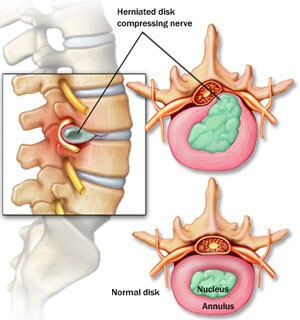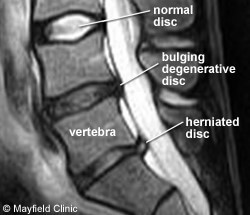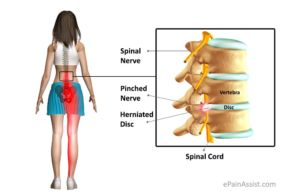Slipped Disc | Symptoms | Treatment
, 6 years ago
What is a slipped disc?
In between our spinal vertebrae, we have intervertebral discs that act as shock absorber and a source of nutrition for them. As shown in the image, a normal disc comprises of inner gelatinous material called as nucleus pulposus and outer fibrocartilaginous ring called annulus fibrosus. If there is break in the continuity of annulus fibrosus, the inner nucleus material may escape out and start putting pressure on the exiting nerve. This is referred to as “Slipped disc”

What are the symptoms?
Each spinal nerve has both sensory and motor components. Sensory part carries the information about the surroundings via the receptors and sends it to the brain. Once this information is processed by the brain, it sends information to the muscles and body parts to bring about movement or other bodily functions via the motor component.
In case of
slipped disc, due to the pressure built up on the nerve, the patient experiences symptoms as follows:
a. Sensory: Pain, tingling, numbness, burning, along the area that is innervated by the sensory part of the affected nerve.
b. Motor: Muscle weakness of the muscles supplied by the involved nerve. The patient will have difficulty with movements thus affecting his daily functions and activities. In long standing cases, the muscle may lose its bulk due to wasting.
What are the treatment options?
a. Conservative
i. Medical:
Your physician can start you on pain relieving medications such as NSAIDS, oral steroids, muscle relaxants etc. He/she may also prescribe medications to soothe the nerves depending upon the case.
ii. Physical therapy:
Physical therapist may use different approaches such as McKenzie, Mulligan, Neurodynamics, Kinetic control, Taping, electrotherapy etc. Few medical movements (based on thorough physical assessment) will be prescribed to you with specific dosage of repetition, frequency and intensity. It is also accompanied with certain do’s and don’ts to ensure that the involved structure is not irritated further.
iii. Passive therapy: These include use of hot and cold packs. They are beneficial in reducing the inflammation.
b. Surgical:
The gold standard surgical procedures are open and micro surgical discectomy. A new technique called micro endoscopic surgery is also available now.
Its outcomes are found to be similar to those of micro discectomy. With further technological advances, these procedures have minimal incision, less tissue damage, faster recovery, and lesser hospitalization.
However, surgical options should only be considered when the nonsurgical approaches have failed or if there is a serious condition that is compromising the patient’s quality of life.
Visit www.qispine.com to learn more




